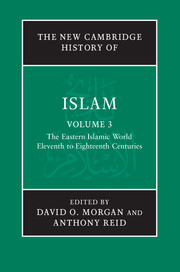Book contents
- Frontmatter
- Introduction: Islam in a plural Asia
- PART I THE IMPACT OF THE STEPPE PEOPLES
- 1 The steppe peoples in the Islamic world
- 2 The early expansion of Islam in India
- 3 Muslim India: the Delhi sultanate
- 4 The rule of the infidels: the Mongols and the Islamic world
- 5 Tamerlane and his descendants: from paladins to patrons
- PART II THE GUNPOWDER EMPIRES
- PART III THE MARITIME OECUMENE
- PART IV THEMES
- Glossary
- Bibliography
- Index
- References
2 - The early expansion of Islam in India
from PART I - THE IMPACT OF THE STEPPE PEOPLES
Published online by Cambridge University Press: 28 March 2011
- Frontmatter
- Introduction: Islam in a plural Asia
- PART I THE IMPACT OF THE STEPPE PEOPLES
- 1 The steppe peoples in the Islamic world
- 2 The early expansion of Islam in India
- 3 Muslim India: the Delhi sultanate
- 4 The rule of the infidels: the Mongols and the Islamic world
- 5 Tamerlane and his descendants: from paladins to patrons
- PART II THE GUNPOWDER EMPIRES
- PART III THE MARITIME OECUMENE
- PART IV THEMES
- Glossary
- Bibliography
- Index
- References
Summary
In the wake of the Islamic conquests, trading activity between the Middle East and India appears to have expanded dramatically. Between the Hellenistic period and the first/seventh century, the Arabs had lost their predominance in this trade to the Ethiopians – Byzantium’s trading partners in the Indian Ocean – and, to an even greater degree, to the latter’s political and commercial rivals, the Sasanid Persians. The early Islamic conquests brought Byzantine/Sasanid rivalry to an abrupt end while bringing the Middle East into a single monetary exchange system and linking the Mediterranean to the Indian Ocean under the aegis of a single imperial polity. Gravitating towards Mesopotamia and the Persian Gulf, the trade with India became the major external source of wealth for Islam, at the same time that the overland route to China acquired much greater significance with the accession of the Tang dynasty in 618 CE. The Islamic trade with India was a trade in pepper (the ‘black gold of India’) and spices in the broadest sense, but included an almost infinite array of other items, from jewels to metallurgical products and ivory, to teakwood and textiles, which were exchanged against precious metals, horses and many manufactured products such as paper, glass and the like.
- Type
- Chapter
- Information
- The New Cambridge History of Islam , pp. 78 - 99Publisher: Cambridge University PressPrint publication year: 2010

